Gallery opened 2 Mar 2020
Updated 9 May 2020
Video of the gasbike in action




Gas-powered Motorcycles |
Gallery opened 2 Mar 2020 |
This idea for running motorcycles from coal gas (town gas) which contained hydrogen, carbon monoxide, methane, and ethylene, surfaced towards the end of WW1, when petrol shortages were starting to bite. It's clearly a very unwieldy set-up, and whether more than one example was made is uncertain.
 | Left: Motorcycle with a gas storage bag attached to the sidecar: 1917
|
I have received this assessment of the idea from Mr J Kreutz, to whom thanks:
"The gas powered motorbike would be rather dangerous: I evaluate the area of the gas container at about 2 mē. that means that with a lateral wind of 25 metre/s (not even 100 km/h) the drag might amount about 750 Newtons, the same force as the one exerted by gravity on a mean motorbike driver. Furthermore, the ratio of cantilever lengths of the center of the gas container, the hight of the motorbike seat, the length of the foot of the driver and so on let me suppose that this vehicle might have been rather dangerous and probably undrivable by bad weather conditions (wind gusts)... I consider here lengths by reference to the contact points of the tires with the road. I ride myself a motorbike (not methane powered!) and gusts with a speed of 100 km/h are still manageable, but require a lot of care of the driver... I can also suppose that speed above 30-40 km/h might have been problematic." |
Having pondered the issue, I too have concluded that this machine would be uncontrollable in any sort of side-wind. There is also the buoyancy of the gasbag to be considered; it would tend to lift the side-car. More on this below.
However, there is now no doubt that the gasbike really did exist:
|
|
|

  
|